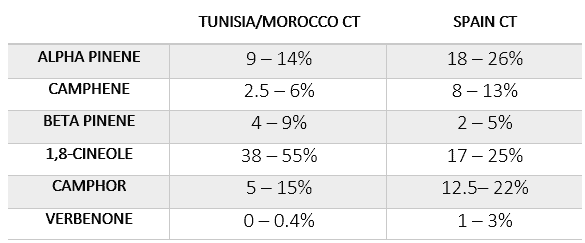| Botanical Name | Rosmarinus Officinalis L. |
| Botanical Family | Lamiaceae |
| Part of the plant | Leafy branchers |
| Cas Number | 8000-25-7 |
| FEMA Number | 2992 |
| Main Origins | Spain, Tunisia, Morocco |
| Harvest Period | Whole year. |
A BIT OF HISTORY
This bush is a condiment and medicinal plant in use since ancient times, and very appreciated in aromatic and wild formulations. Around 65 A.D., Dioscorides recommended Rosemary for its “warming faculty” in his “De Materia Medica”, one of the most influential herbal books in history, and precursor of the pharmacopoeia. Its medicinal properties were described in Arabic treatises of the 13th century. The crippled old queen of Hungary popularized it by regularly ingesting a famous elixir (a tincture of Rosemary flowers) that restored her youth and beauty. In the 19th century, Napoleon also enhanced its restoration and antiseptic properties.

PLANT DESCRIPTION
The plant is a 60 cm to 2 m high shrub. It has numerous branches and small needle-shaped leaves that remain evergreen all year round, and blue flowers that are tinged with violet inside. Flowering can extend throughout the year.
OIL PRODUCTION
It is produced by steam distillation from plants located mainly in the Mediterranean basin, from sea level to 1,500 meters high, being more rich in oil at high altitude. The yield of this oil is between 0.8% and 1.5%. The highest yield is achieved in Spring and Autumn.
Until recently it was distilled mainly in Spain, and small quantities in France and other places such as Corsica.
Today, no more than 25 to 30 tonnes a year are distilled in this country, mainly due to the increase in the price of oil, both because of the increase in wages and because of the speculation that has been practised with oil, especially in times of scarcity.
This has led to a shift in production to other countries that may have lower operating costs, especially in North Africa, where more than 100 tonnes a year can be produced.
The extracts of this plant (both CO2 supercritical and conventional) were approved as antioxidants by European regulations, due to their phenolic acids (Carnosic and Rosmarinic).
A BIT OF CHEMISTRY
Rosemary oil is the perfect example of the same species and distilled plant part, giving different chemotypes depending on climatic and soil conditions.
Most commonly found chemotypes on the market are:
- Camphor CT (mainly produced in Spain): Its odor profile is more appreciated than Cineole CT, having camphoraceous and oily notes. Its main biomarker is called “Verbenone” and it is a key ketone only present in a few natural products at a significant concentration.
- Cineole CT (mainly produced in Morocco and Tunisia): The high content of Eucalyptol makes the olfactory profile very diffusive and aromatic, close to eucalyptus oil.
- Verbenone CT: It is a less common chemotype, mainly produced in Egypt, Corsica and South-Africa. It shows the highest content of Verbenone (up to 13%).

Regarding to the active substances, Cineole and Camphor make it a good expectorant remedy. Furthermore, as previously mentioned, Carnosic and Rosmarinic Acids are the two main phenolic diterpene compounds of the extract (not the essential oil), both being the main responsible of its antioxidant properties.




Some commonly adulterants applied to this oil are: Turpentine oil fractions, Eucalyptus oil and fractions and white camphor oil and fractions.
REGULATION & SPECS
- Monographs: ISO 1342, European Pharmacopoeia, FCC.
- IFRA: Permitted (Restricted constituents: Methyl Eugenol)
- Cosmetic Allergens: Limonene, Linalool, Citral, Citronellol, Eugenol.
APLICATIONS
- In fragrances, flavors, pharmacy, cosmetics and aromatherapy
- A typical example of the application of this oil in pharmacy is “rosemary alcohol”, a product used for muscle pains that is often falsely claimed to be anti-cellulite.
The product sold in pharmacies is not a macerate, but an alcoholic solution of the essential oil, and in many cases is a mixture of the active ingredients for this purpose, such as terpenes, cineol and camphor.
References
– Use of rosemary extracts as a food additive, The EFSA Journal (2008) 721, 1-29
– Rosemary. B. Sasikumar, Indian Institute of Spices Research, India (2012)
– Ruiz García, M., Ruiz Cardenete, A., Ruiz Cardenete, J. El mundo de los aceites esenciales. La guía definitiva, 1st ed. AMV Ediciones, Madrid, Spain, 2020
– Aetheroleum Rosmarini, WHO monograph.
– Rosmarinus officinalis L.: an update review of its phytochemistry and biological activity. Andrade et al. (2017)
– European Medicines Agency. Community herbal monograph on Rosmarinus officinalis L., aetheroleum (2010)
– Universal Encyclopaedia of Phyto-Aromatherapy, acphytaroma.
– Essential Oil Safety: A Guide for Health Care Professionals, Robert Tisserand, Rodney Young (2014)
– Rosemary oil, European Pharmacopeia. 01/2008:1846
– Essential oil of rosemary. ISO 1342:2012
